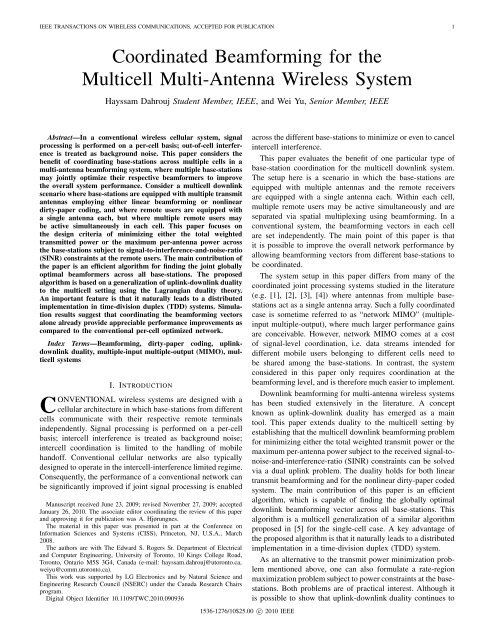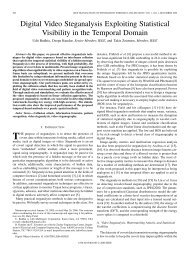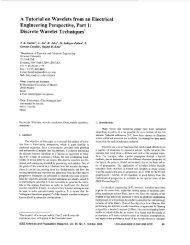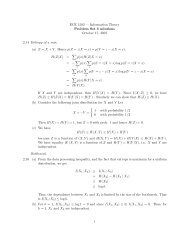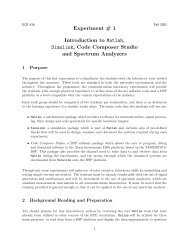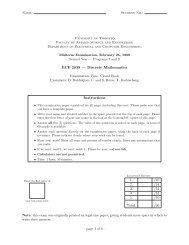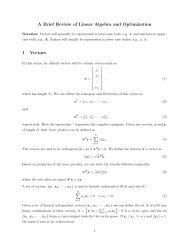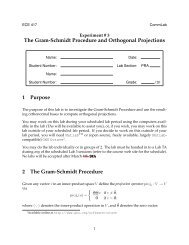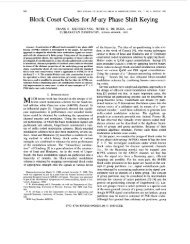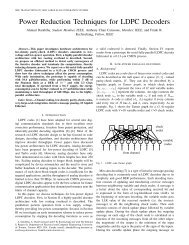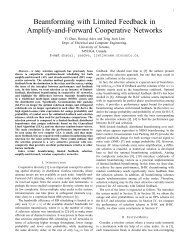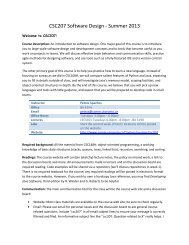Coordinated Beamforming for the Multicell Multi-Antenna Wireless ...
Coordinated Beamforming for the Multicell Multi-Antenna Wireless ...
Coordinated Beamforming for the Multicell Multi-Antenna Wireless ...
Create successful ePaper yourself
Turn your PDF publications into a flip-book with our unique Google optimized e-Paper software.
IEEE TRANSACTIONS ON WIRELESS COMMUNICATIONS, ACCEPTED FOR PUBLICATION 1<strong>Coordinated</strong> <strong>Beam<strong>for</strong>ming</strong> <strong>for</strong> <strong>the</strong><strong><strong>Multi</strong>cell</strong> <strong>Multi</strong>-<strong>Antenna</strong> <strong>Wireless</strong> SystemHayssam Dahrouj Student Member, IEEE, and Wei Yu, Senior Member, IEEEAbstract—In a conventional wireless cellular system, signalprocessing is per<strong>for</strong>med on a per-cell basis; out-of-cell interferenceis treated as background noise. This paper considers <strong>the</strong>benefit of coordinating base-stations across multiple cells in amulti-antenna beam<strong>for</strong>ming system, where multiple base-stationsmay jointly optimize <strong>the</strong>ir respective beam<strong>for</strong>mers to improve<strong>the</strong> overall system per<strong>for</strong>mance. Consider a multicell downlinkscenario where base-stations are equipped with multiple transmitantennas employing ei<strong>the</strong>r linear beam<strong>for</strong>ming or nonlineardirty-paper coding, and where remote users are equipped witha single antenna each, but where multiple remote users maybe active simultaneously in each cell. This paper focuses on<strong>the</strong> design criteria of minimizing ei<strong>the</strong>r <strong>the</strong> total weightedtransmitted power or <strong>the</strong> maximum per-antenna power across<strong>the</strong> base-stations subject to signal-to-interference-and-noise-ratio(SINR) constraints at <strong>the</strong> remote users. The main contribution of<strong>the</strong> paper is an efficient algorithm <strong>for</strong> finding <strong>the</strong> joint globallyoptimal beam<strong>for</strong>mers across all base-stations. The proposedalgorithm is based on a generalization of uplink-downlink dualityto <strong>the</strong> multicell setting using <strong>the</strong> Lagrangian duality <strong>the</strong>ory.An important feature is that it naturally leads to a distributedimplementation in time-division duplex (TDD) systems. Simulationresults suggest that coordinating <strong>the</strong> beam<strong>for</strong>ming vectorsalone already provide appreciable per<strong>for</strong>mance improvements ascompared to <strong>the</strong> conventional per-cell optimized network.Index Terms—<strong>Beam<strong>for</strong>ming</strong>, dirty-paper coding, uplinkdownlinkduality, multiple-input multiple-output (MIMO), multicellsystemsI. INTRODUCTIONCONVENTIONAL wireless systems are designed with acellular architecture in which base-stations from differentcells communicate with <strong>the</strong>ir respective remote terminalsindependently. Signal processing is per<strong>for</strong>med on a per-cellbasis; intercell interference is treated as background noise;intercell coordination is limited to <strong>the</strong> handling of mobilehandoff. Conventional cellular networks are also typicallydesigned to operate in <strong>the</strong> intercell-interference limited regime.Consequently, <strong>the</strong> per<strong>for</strong>mance of a conventional network canbe significantly improved if joint signal processing is enabledManuscript received June 23, 2009; revised November 27, 2009; acceptedJanuary 26, 2010. The associate editor coordinating <strong>the</strong> review of this paperand approving it <strong>for</strong> publication was A. Hjørungnes.The material in this paper was presented in part at <strong>the</strong> Conference onIn<strong>for</strong>mation Sciences and Systems (CISS), Princeton, NJ, U.S.A., March2008.The authors are with The Edward S. Rogers Sr. Department of Electricaland Computer Engineering, University of Toronto, 10 Kings College Road,Toronto, Ontario M5S 3G4, Canada (e-mail: hayssam.dahrouj@utoronto.ca,weiyu@comm.utoronto.ca).This work was supported by LG Electronics and by Natural Science andEngineering Research Council (NSERC) under <strong>the</strong> Canada Research Chairsprogram.Digital Object Identifier 10.1109/TWC.2010.0909361536-1276/10$25.00 c○ 2010 IEEEacross <strong>the</strong> different base-stations to minimize or even to cancelintercell interference.This paper evaluates <strong>the</strong> benefit of one particular type ofbase-station coordination <strong>for</strong> <strong>the</strong> multicell downlink system.The setup here is a scenario in which <strong>the</strong> base-stations areequipped with multiple antennas and <strong>the</strong> remote receiversare equipped with a single antenna each. Within each cell,multiple remote users may be active simultaneously and areseparated via spatial multiplexing using beam<strong>for</strong>ming. In aconventional system, <strong>the</strong> beam<strong>for</strong>ming vectors in each cellare set independently. The main point of this paper is thatit is possible to improve <strong>the</strong> overall network per<strong>for</strong>mance byallowing beam<strong>for</strong>ming vectors from different base-stations tobe coordinated.The system setup in this paper differs from many of <strong>the</strong>coordinated joint processing systems studied in <strong>the</strong> literature(e.g. [1], [2], [3], [4]) where antennas from multiple basestationsact as a single antenna array. Such a fully coordinatedcase is sometime referred to as “network MIMO” (multipleinputmultiple-output), where much larger per<strong>for</strong>mance gainsare conceivable. However, network MIMO comes at a costof signal-level coordination, i.e. data streams intended <strong>for</strong>different mobile users belonging to different cells need tobe shared among <strong>the</strong> base-stations. In contrast, <strong>the</strong> systemconsidered in this paper only requires coordination at <strong>the</strong>beam<strong>for</strong>ming level, and is <strong>the</strong>re<strong>for</strong>e much easier to implement.Downlink beam<strong>for</strong>ming <strong>for</strong> multi-antenna wireless systemshas been studied extensively in <strong>the</strong> literature. A conceptknown as uplink-downlink duality has emerged as a maintool. This paper extends duality to <strong>the</strong> multicell setting byestablishing that <strong>the</strong> multicell downlink beam<strong>for</strong>ming problem<strong>for</strong> minimizing ei<strong>the</strong>r <strong>the</strong> total weighted transmit power or <strong>the</strong>maximum per-antenna power subject to <strong>the</strong> received signal-tonoise-and-interference-ratio(SINR) constraints can be solvedvia a dual uplink problem. The duality holds <strong>for</strong> both lineartransmit beam<strong>for</strong>ming and <strong>for</strong> <strong>the</strong> nonlinear dirty-paper codedsystem. The main contribution of this paper is an efficientalgorithm, which is capable of finding <strong>the</strong> globally optimaldownlink beam<strong>for</strong>ming vector across all base-stations. Thisalgorithm is a multicell generalization of a similar algorithmproposed in [5] <strong>for</strong> <strong>the</strong> single-cell case. A key advantage of<strong>the</strong> proposed algorithm is that it naturally leads to a distributedimplementation in a time-division duplex (TDD) system.As an alternative to <strong>the</strong> transmit power minimization problemmentioned above, one can also <strong>for</strong>mulate a rate-regionmaximization problem subject to power constraints at <strong>the</strong> basestations.Both problems are of practical interest. Although itis possible to show that uplink-downlink duality continues to
2 IEEE TRANSACTIONS ON WIRELESS COMMUNICATIONS, ACCEPTED FOR PUBLICATIONhold <strong>for</strong> <strong>the</strong> rate region maximization problem under suitableconditions (e.g. sum power constraint across all <strong>the</strong> transmitters),numerical optimization of achievable rate regionsbecomes much more difficult. For this reason, <strong>the</strong> remainderof this paper restricts its attention to <strong>the</strong> power minimizationproblem subject to SINR constraints.A. Related WorkThe benefit of base-station coordination in a cellular networkhas been a subject of many recent studies. Motivatedby <strong>the</strong> joint detection and cooperation techniques <strong>for</strong> intracellinterference mitigation, [1], [2], [3], [4], [6], [7], [8] study <strong>the</strong>capacity improvement due to <strong>the</strong> joint encoding or decodingacross <strong>the</strong> base-stations <strong>for</strong> intercell interference mitigation.Base-station coordination is practically conceivable becausein a cellular network base-stations are connected by highcapacitybackhaul links. However, <strong>the</strong> amount of backhaulcommunications required to achieve joint processing is alsosubstantial. This motivates network models with ei<strong>the</strong>r constrainedbackhaul capacity [9], [10], [11] or with cooperationonly among neighboring base-stations [12], [13], [14] oramong cluster of base-stations [15].The problem setting in this paper differs from <strong>the</strong> aboveseries of works in that ra<strong>the</strong>r than joint processing at asignal level, we consider coordination at <strong>the</strong> beam<strong>for</strong>mer level,which requires much less overhead and is more practical toimplement. In particular, <strong>the</strong> data stream <strong>for</strong> each user onlyneeds to be (pre-)processed at its own base-station (and notacross all <strong>the</strong> base-stations). Fur<strong>the</strong>r, <strong>the</strong> base-stations neednot be symbol synchronized as required with signal-levelcoordination. With <strong>the</strong>se practical considerations, this paperfocuses on <strong>the</strong> joint optimization of transmit beam<strong>for</strong>mersacross <strong>the</strong> base-stations <strong>for</strong> minimizing <strong>the</strong> transmit powersubject to quality-of-service constraints at <strong>the</strong> mobiles. Thissetup is suitable <strong>for</strong> constant bit-rate traffic with stringentdelay constraints. As <strong>the</strong> simulation results of this papershow, appreciable per<strong>for</strong>mance gain can already be obtainedwith this limited <strong>for</strong>m of coordination. Related works basedon <strong>the</strong> minimization of packet loss probability [16] and <strong>the</strong>maximization of capacity [17], [18] have also been reportedin <strong>the</strong> literature.The transmit beam<strong>for</strong>ming design problem goes back to<strong>the</strong> classic work of [19], where an iterative algorithm isproposed <strong>for</strong> <strong>the</strong> optimization of <strong>the</strong> beam<strong>for</strong>ming vectorsand power allocations to satisfy a set of target SINRs <strong>for</strong> anarbitrary set of transmission links. The main contribution of[19] is a beam<strong>for</strong>mer-power update algorithm based on anuplink-downlink duality that converges to a feasible solutionto <strong>the</strong> problem. In <strong>the</strong> single-cell multi-user downlink case,<strong>the</strong> optimality of this duality-based approach is proved in[20] and [21], [22]. More recently, [5] shows that <strong>the</strong> singlecelldownlink beam<strong>for</strong>ming problem can be <strong>for</strong>mulated as asecond-order cone-programming problem. This crucial insightallows an interpretation of duality via Lagrangian <strong>the</strong>ory inconvex optimization [23].The single-cell uplink-downlink duality can be immediatelygeneralized to <strong>the</strong> multicell setting if signal-level coordinationbetween <strong>the</strong> base-stations is assumed. This is shown in [24]in a CDMA context, where a beam<strong>for</strong>mer-power iterationalgorithm similar to that of [19] is proposed.Less obvious is <strong>the</strong> question of whe<strong>the</strong>r uplink-downlinkduality continues to hold in a multicell network withbeam<strong>for</strong>ming-level coordination only. This paper uses a Lagrangianduality approach to establish that duality indeedexists in this case. In addition, this paper proposes an optimizationprocedure based on power iteration alone. Theproposed algorithm has a key advantage of being amenableto distributed implementation, which is highly desirable ina multicell network. Fur<strong>the</strong>r, this paper takes realistic powerconstraint into account by solving <strong>the</strong> problem of minimizing<strong>the</strong> maximum per-antenna power constraint across all <strong>the</strong> basestations.Finally, this paper provides a generalization to includedirty-paper coding within each cell.The multicell uplink-downlink duality considered in thispaper is related to <strong>the</strong> concept of network duality proposedin [25]. However, <strong>the</strong> network duality established in [25] isderived based on a linear programming approach, which isdifferent from <strong>the</strong> Lagrangian approach taken in this paper.Consequently, [25] arrives at a different set of numericalalgorithms <strong>for</strong> <strong>the</strong> coordinated beam<strong>for</strong>ming problem, whichhappen to be not as easily implementable in a distributedfashion. In fact, to obtain distributed solutions, [25] has toresort to suboptimal algorithms. As a fur<strong>the</strong>r note, [25] dealswith <strong>the</strong> more general problem of joint transmit and receivebeam<strong>for</strong>ming optimization <strong>for</strong> a multicell network where both<strong>the</strong> base-station and <strong>the</strong> remote users are equipped with multipleantennas. Although uplink-downlink duality continues tohold, one consequence of this more general setup is that <strong>the</strong>proof of global optimality is no longer available, in contrastto <strong>the</strong> simpler single-antenna-per-remote-user case consideredin this paper. Finally, <strong>the</strong> coordinated beam<strong>for</strong>ming problemcan also be solved using yet ano<strong>the</strong>r different approach basedon treating all <strong>the</strong> base-stations as a single transmitter, <strong>the</strong>nmodifying <strong>the</strong> corresponding channel matrix and determining<strong>the</strong> corresponding optimal beam<strong>for</strong>ming vectors [26]. However,distributed implementation of <strong>the</strong> resulting algorithm isnot yet available.Coordination at <strong>the</strong> beam<strong>for</strong>ming-level <strong>for</strong> <strong>the</strong> multicellmulti-antenna channel has also been explored in [27], [28]from a viewpoint of egotistic vs. altruistic strategies. Theseworks focus on <strong>the</strong> Pareto boundary of <strong>the</strong> achievable rateregion of <strong>the</strong> multicell network under fixed power constraint,which is complementary to <strong>the</strong> problem of power minimizationunder fixed SINR constraints considered in this paper. Theachievable rate region of multicell systems has also beenexplored in [29] using duality, and in [30]. In particular,[30] deals with a more general setting with different possiblelevels of coordination between <strong>the</strong> base-stations. The problemsetting of <strong>the</strong> current paper corresponds to a particular limitedcoordination scenario in [30]. Fur<strong>the</strong>r, [30] also addresses <strong>the</strong>issue of imperfect channel knowledge at <strong>the</strong> base-stations.The problem setting of this paper assumes that <strong>the</strong> setof active mobile users with each cell and <strong>the</strong>ir respectiveSINR constraints are fixed. User scheduling (e.g. [31], [32],[33]) and congestion control strategies (e.g. [26]) are assumedto be per<strong>for</strong>med separately. Throughout <strong>the</strong> paper, perfectchannel side in<strong>for</strong>mation <strong>for</strong> mobile users within each cell
DAHROUJ and YU: COORDINATED BEAMFORMING FOR THE MULTICELL MULTI-ANTENNA WIRELESS SYSTEM 3is assumed to be available at each base-station. In a practicalimplementation, channel side in<strong>for</strong>mation may be estimatedvia channel reciprocity <strong>for</strong> a TDD system or via a feedbackmechanism; see [34], [35].B. OrganizationThe remainder of <strong>the</strong> paper is organized as follows. SectionII contains <strong>the</strong> problem <strong>for</strong>mulation and <strong>the</strong> system model.In Section III, we establish uplink-downlink duality <strong>for</strong> <strong>the</strong>multicell network <strong>for</strong> problem of minimizing ei<strong>the</strong>r <strong>the</strong> totalweighted transmit power or <strong>the</strong> maximum per-antenna powersubject to SINR constraints. Section IV contains distributedalgorithms <strong>for</strong> multicell downlink beam<strong>for</strong>ming. Section Vprovides simulation results. Concluding remarks are made inSection VI.Notations: R and C denote <strong>the</strong> real and complex spaces. Theidentity matrix is denoted as I. The transpose and Hermitiantranspose of a matrix are denoted as (.) T and (.) H respectively.II. PROBLEM FORMULATIONA. System ModelThis paper considers a multicell multi-user spatial multiplexsystem with N cells and K users per cell with N t antennasat each base-station and a single antenna at each remoteuser. <strong>Multi</strong>user downlink transmit beam<strong>for</strong>ming is employedat each base-station. Let x i,j be a complex scalar denoting<strong>the</strong> in<strong>for</strong>mation signal <strong>for</strong> <strong>the</strong> jth user in <strong>the</strong> ith cell, andw i,j ∈ C Nt×1 be its associated beam<strong>for</strong>ming vector. Thereceived signal at <strong>the</strong> jth remote user in <strong>the</strong> ith cell, denotedas y i,j ∈C, is a summation of <strong>the</strong> intended signal, intracellinterference, and intercell interference:y i,j = ∑ h H i,i,jw i,l x i,l + ∑h H m,i,jw m,n x m,n + z i,j (1)lm≠i,nwhere h l,i,j ∈C Nt×1 is <strong>the</strong> vector channel from <strong>the</strong> basestationof <strong>the</strong> lth cell to <strong>the</strong> jth user in <strong>the</strong> ith cell, and z i,jis <strong>the</strong> additive white circularly symmetric Gaussian complexnoise with variance σ 2 /2 on each of its real and imaginarycomponents. Fig. 1 illustrates <strong>the</strong> system model <strong>for</strong> a networkwith seven cells and three users per cell.B. Transmit <strong>Beam<strong>for</strong>ming</strong> ProblemThe beam<strong>for</strong>mer design problem is that of minimizing somefunction of transmit power across all base-stations subjectto SINR constraints at <strong>the</strong> remote users. With w i,j as <strong>the</strong>beam<strong>for</strong>ming vectors, <strong>the</strong> SINR <strong>for</strong> <strong>the</strong> jth user in <strong>the</strong> ithcell can be expressed as:|wi,j H Γ i,j =h i,i,j| 2∑l≠j |wH i,l h i,i,j| 2 + ∑ m≠i,n |wH m,n h m,i,j| 2 + σ 2 (2)Let γ i,j be <strong>the</strong> SINR target <strong>for</strong> <strong>the</strong> jth user in <strong>the</strong> ith cell.We can <strong>the</strong>n <strong>for</strong>mulate, <strong>for</strong> example, a total transmit powerminimization problem as follows:∑minimize wi,jw H i,j (3)i,jsubject to Γ i,j ≥ γ i,j , ∀i =1···N, j =1···Kwhere <strong>the</strong> minimization is over <strong>the</strong> w i,j ’s. Throughout thispaper, we assume that <strong>the</strong> set of SINR targets are feasible.Fig. 1.<strong><strong>Multi</strong>cell</strong> wireless network.C. Conventional SystemsIn a conventional wireless cellular system, <strong>the</strong> multiuserbeam<strong>for</strong>ming problem is solved on a per-cell basis; out-ofcellinterference is regarded as a part of background noise.In particular, <strong>for</strong> a fixed base-station î, a conventional systemfinds <strong>the</strong> optimal set of wî,j , j =1···K, assuming that allo<strong>the</strong>r (N − 1)K beam<strong>for</strong>mers are fixed:∑minimize w H w î,j î,j(4)jsubject to Γî,j ≥ γî,j , ∀j =1···Kwhere Γî,j is given by (2). This single-cell downlink problemhas a classic solution as given in [19], [20], [21], [5].Note that in a conventional system, <strong>the</strong> choice of beam<strong>for</strong>mersat each base-station affects <strong>the</strong> background noise levelat neighboring cells, and hence <strong>the</strong> setting of beam<strong>for</strong>mersin neighboring base-stations. Thus, <strong>the</strong> above per-cell optimizationis in practice per<strong>for</strong>med iteratively until <strong>the</strong> systemconverges to a per-cell optimal solution.D. Motivating Example <strong>for</strong> Joint OptimizationThis paper is motivated by <strong>the</strong> observation that <strong>the</strong> percelloptimization above does not necessarily lead to a jointoptimal solution. Significant per<strong>for</strong>mance improvement maybe obtained if base-stations coordinate in jointly optimizing allof <strong>the</strong>ir beam<strong>for</strong>mers at <strong>the</strong> same time. The following exampleillustrates this point.Consider a multicell network but with only a single user percell. The per-cell optimization reduces to <strong>the</strong> optimal transmitbeam<strong>for</strong>ming problem <strong>for</strong> a multi-input single-output (MISO)system with a background noise level which includes outof-cellinterference. Note that regardless of <strong>the</strong> level of <strong>the</strong>background noise, <strong>the</strong> optimal per-cell transmit beam<strong>for</strong>mer is
4 IEEE TRANSACTIONS ON WIRELESS COMMUNICATIONS, ACCEPTED FOR PUBLICATIONa vector that matches <strong>the</strong> channel. Thus, in this example, percelloptimization across <strong>the</strong> cells converges in one iteration—every base-station uses a transmit beam<strong>for</strong>mer that matches<strong>the</strong> MISO channel.This channel-matching solution is not necessarily <strong>the</strong> jointoptimum. For example, when two users belonging to twodifferent cells are near each o<strong>the</strong>r at <strong>the</strong> cell edge, it maybe advantageous to steer <strong>the</strong> beam<strong>for</strong>ming vectors <strong>for</strong> <strong>the</strong> twobase-stations away from each o<strong>the</strong>r so as to reduce mutualinterference. Such a joint optimal beam<strong>for</strong>ming solution maylead to higher received SINRs at a fixed transmit power, orconversely a lower transmit power at fixed SINRs.One of <strong>the</strong> first algorithms <strong>for</strong> solving <strong>the</strong> multicelljoint beam<strong>for</strong>ming optimization problem is given by Rashid-Farrokhi, Liu and Tassiulas [19]. They showed that <strong>the</strong> optimaldownlink beam<strong>for</strong>ming problem under SINR constraints canbe solved efficiently by an iterative uplink beam<strong>for</strong>mer andpower update algorithm. It is well known that <strong>the</strong> uplinkbeam<strong>for</strong>ming problem is much easier to solve [36]. Thus, bytrans<strong>for</strong>ming <strong>the</strong> downlink problem into <strong>the</strong> uplink domain,<strong>the</strong> downlink problem may be solved efficiently as well.The global optimality of <strong>the</strong> beam<strong>for</strong>mer-power iterationalgorithm has been shown <strong>for</strong> <strong>the</strong> single-cell case in [20],[21], [5]. This paper gives a rigorous derivation of duality <strong>for</strong><strong>the</strong> multicell case, <strong>the</strong>n proposes a new algorithm <strong>for</strong> solving<strong>the</strong> joint multicell downlink beam<strong>for</strong>ming problem.III. UPLINK-DOWNLINK DUALITY FOR MULTICELLSYSTEMSA. Minimization of Weighted Transmitted PowerWe begin by <strong>for</strong>mulating a slightly more general version of<strong>the</strong> transmit beam<strong>for</strong>ming problem (3). In a multicell system,each base-station (or sometime each antenna) typically has itsown power constraint. Thus, it is useful to consider a problemof minimizing <strong>the</strong> weighted total transmit power, with <strong>the</strong>transmit power at <strong>the</strong> ith base-station weighted by a factorα i . In this case, (3) becomes∑minimize α i wi,j H w i,j (5)i,jsubject to Γ i,j ≥ γ i,j , ∀i =1···N, j =1···KThe SINR target constraints in (5) may appear nonconvex.In a study of single-cell downlink beam<strong>for</strong>ming problem, [5]showed that SINR constraints of this type can be trans<strong>for</strong>medinto a second-order-cone constraint (see also [37]). This crucialobservation enables methods <strong>for</strong> solving (5) via convexoptimization.Uplink-downlink duality refers to <strong>the</strong> fact that <strong>the</strong> minimumtransmit power needed to achieve a certain set of SINRconstraints in a downlink channel is <strong>the</strong> same as <strong>the</strong> minimumtotal transmit power needed to achieve <strong>the</strong> same set of SINRtargets in an uplink channel, where <strong>the</strong> uplink channel isobtained by reversing <strong>the</strong> input and <strong>the</strong> output of <strong>the</strong> downlink.The main goal of this section is to show that uplink-downlinkduality, previously established <strong>for</strong> <strong>the</strong> single-cell case, carriesover to <strong>the</strong> multicell setting. The following <strong>the</strong>orem is amulticell generalization of <strong>the</strong> single-cell duality result asstated in [23]. The proof is based on a Lagrangian technique,similar to <strong>the</strong> approach used in [23].Theorem 1: The optimal transmit beam<strong>for</strong>ming problem(5) <strong>for</strong> <strong>the</strong> downlink multiuser multi-cellular network canbe solved via a dual uplink channel in which <strong>the</strong> SINRconstraints remain <strong>the</strong> same and <strong>the</strong> noise power is scaledby α i . Ma<strong>the</strong>matically, a Lagrangian dual of <strong>the</strong> optimizationproblem <strong>for</strong> <strong>the</strong> downlink (5) is <strong>the</strong> following uplink problem:∑minimize λ i,j σ 2 (6)subject toi,jΛ i,j ≥ γ i,jwhere <strong>the</strong> minimization is over λ i,j ,andλ i,j |ŵi,j H Λ i,j =maxh i,i,j| 2ŵ i,j∑(m,l)≠(i,j) λ m,l|ŵi,j H h i,m,l| 2 + α i ||ŵ i,j || . 2The optimal ŵ i,j has <strong>the</strong> interpretation of being <strong>the</strong> receiverbeam<strong>for</strong>mer of <strong>the</strong> dual uplink channel, and is a scaled versionof <strong>the</strong> optimal w i,j . The optimal λ i,j has <strong>the</strong> interpretation ofbeing <strong>the</strong> dual uplink power, and it corresponds to <strong>the</strong> dualvariable associated with <strong>the</strong> SINR constraint of (5).Proof: The proof hinges upon <strong>the</strong> fact that <strong>the</strong> SINRconstraints can be re<strong>for</strong>mulated as a second-order coneprogrammingproblem as shown in [5]. There<strong>for</strong>e, strongduality holds <strong>for</strong> (5). This allows us to characterize <strong>the</strong> solutionof (5) via its Lagrangian:L(w i,j ,λ i,j )= ∑ α i wi,j H w i,j − ∑ [|wHi,jh i,i,j | 2λ i,j −γi,ji,ji,j∑|wi,l H h i,i,j| 2 − ∑]|wm,n H h m,i,j| 2 − σ 2 (7)l≠jm≠i,nRearranging (7), we get:L(w i,j ,λ i,j )= ∑ λ i,j σ 2 + ∑ [wi,jH α i I−i,ji,j(1+ 1 )λ i,j h i,i,j h H i,i,jγ + ∑ ]λ m,n h i,m,n h H i,m,n w i,ji,jm,n(8)The dual objective isg(λ i,j )=minL(w i,j ,λ i,j ) (9)w i,j( )It is easy to see that if α i I − 1+ 1γ i,jλ i,j h i,i,j h H i,i,j∑+m,n λ m,nh i,m,n h H i,m,nis not a positive definite matrix, <strong>the</strong>n<strong>the</strong>re exists a set of w i,j that would make g(λ i,j )=−∞.Thus, <strong>the</strong> Lagrangian dual of (5), which is <strong>the</strong> maximum ofg(λ i,j ),is∑maximize λ i,j σ 2 (10)wheresubject toi,jΣ i ≽(1+ 1γ i,j)λ i,j h i,i,j h H i,i,jΣ i α i I + ∑ m,nλ m,n h i,m,n h H i,m,n (11)
DAHROUJ and YU: COORDINATED BEAMFORMING FOR THE MULTICELL MULTI-ANTENNA WIRELESS SYSTEM 5Next, we show that <strong>the</strong> above dual is equivalent to (6). Theproblem (6) corresponds to an uplink channel with receivebeam<strong>for</strong>mers ŵ i,j , where <strong>the</strong> noise power of <strong>the</strong> dual channelis scaled by α i . The optimal receive beam<strong>for</strong>mers ŵ i,j thatmaximize <strong>the</strong> SINR are <strong>the</strong> minimum-mean-squared-error(MMSE) receivers, which can be expressed as:⎛ŵ i,j = ⎝ ∑ λ m,l σ 2 h i,m,l h H i,m,l + α iσ 2 I⎠m,l⎞−1h i,i,j (12)where <strong>the</strong> (j, n)-th entry of each K × K sub-matrix F im isdefined as follows:⎧1⎪⎨F imγ i,j|ŵi,j H h i,i,j| 2 if m = i and n = j,jn = −|ŵi,n ⎪⎩H h i,i,j| 2 if m = i and n ≠ j, (17)−|ŵm,n H h m,i,j| 2 if m ≠ iThe δ i,j ’s can be found by taking <strong>the</strong> inverse of <strong>the</strong> matrix F:δ = F −1 1σ 2 (18)Plugging ŵ i,j into <strong>the</strong> SINR constraint of (6), one can showthat <strong>the</strong> SINR constraint is equivalent toα i I + ∑ (λ m,n h i,m,n h H i,m,n ≼ 1+ 1 )λ i,j h i,i,j h H i,i,jγm,ni,jThus, one can rewrite (6) as follows:∑minimize λ i,j σ 2 (13)subject toi,jΣ i ≼(1+ 1γ i,j)λ i,j h i,i,j h H i,i,jNote that <strong>the</strong> problems in (10) and (13) are identical exceptthat <strong>the</strong> maximization is replaced by minimization and <strong>the</strong>inequality constraints are reversed. It can be shown that<strong>the</strong> optimal solutions <strong>for</strong> both problems are such that <strong>the</strong>constraints are satisfied with equality. Thus, (10) and (13) give<strong>the</strong> same solutions.In addition, it can be shown that w i,j and ŵ i,j are scaledversions of each o<strong>the</strong>r. Thus, one would be able to find w i,jby first finding ŵ i,j , <strong>the</strong>n updating it through scalar multiplesδ i,jw i,j = √ δ i,j ŵ i,j . (14)The δ i,j can be found through a matrix inversion using <strong>the</strong>fact that <strong>the</strong> SINR constraints in (5) are satisfied with equality.Plugging (14) into <strong>the</strong> SINR constraint of (5), one can rewrite<strong>the</strong> SINR contraint as:1|ŵi,j H γ h i,i,j| 2 δ i,j − ∑ |ŵi,n H h i,i,j| 2 δ i,ni,jn≠j− ∑|ŵm,nh H m,i,j | 2 δ m,n = σ 2 (15)δ im≠i,nDefine δ i =[δ i,1 ,δ i,2 , ··· ,δ i,K ] T <strong>for</strong> i =1···N and δ =[δ T 1 ,δ T 2 , ··· ,δ T N ]T . Based on (15), one can writeFδ =1σ 2 . (16)Here, 1 is <strong>the</strong> NK × 1 all ones-vector and F is <strong>the</strong> followingNK × NK matrix:⎡⎤F 11 F 12 ··· F 1NF 21 F 22 ··· F 2NF =.⎢ .⎥⎣ .⎦F N1 F N2 ··· F NNB. Minimization of Maximum <strong>Antenna</strong> PowerThe weighting factors α i in Theorem 1 provide a mechanismto trade off <strong>the</strong> power consumptions at different basestationsin a multicell network. It is also straight<strong>for</strong>ward to introduceadditional weighting factors to account <strong>for</strong> power consumptiontradeoff at <strong>the</strong> per-antenna level. However, choosing<strong>the</strong> right weights is often not easy. But if we consider apractical scenario of minimizing <strong>the</strong> maximum antenna poweracross all <strong>the</strong> base-stations, <strong>the</strong> weights adjustment can bedone automatically using a fur<strong>the</strong>r extension of duality. Theoptimization problem in this case is <strong>for</strong>mulated as follows:minimize τ (19)subject to Γ i,j ≥ γ i,j , ∀i, j⎡ ⎤⎣ ∑ w i,j wi,jH ⎦ ≤ τ, ∀i, mjm,mwhere [·] m,n denotes <strong>the</strong> (m, n)-th entry of a matrix. Thefollowing <strong>the</strong>orem is a multicell generalization of <strong>the</strong> singlecellper-antenna power minimization problem treated in [23].Theorem 2: The optimal maximum antenna power transmitbeam<strong>for</strong>ming problem (19) <strong>for</strong> <strong>the</strong> downlink multiuser multicellularnetwork can be solved via a dual uplink channelin which <strong>the</strong> SINR constraints remain <strong>the</strong> same and <strong>the</strong>noise is uncertain. Ma<strong>the</strong>matically, a Lagrangian dual of <strong>the</strong>optimization problem (19) is <strong>the</strong> following max-min problem:wheremaxQ iminλ i,jsubject to∑λ i,j σ 2 (20)i,jΛ i,j ≥ γ i,j ∀ i, jtr(Q i ) ≤ N t , Q i diagonal,Q i ≽ 0 ∀ iλ i,j |ŵi,j H Λ i,j =maxh i,i,j| 2ŵ i,j∑(m,l)≠(i,j) λ m,l|ŵi,j H h i,m,l| 2 + ŵi,j H Q .iŵ i,jThe optimal ŵ i,j has <strong>the</strong> interpretation of being <strong>the</strong> receiverbeam<strong>for</strong>mer of <strong>the</strong> dual uplink channel, and is a scaled versionof <strong>the</strong> optimal w i,j . The optimal λ i,j has <strong>the</strong> interpretation ofbeing <strong>the</strong> dual uplink power, and it corresponds to <strong>the</strong> dualvariable associated with <strong>the</strong> SINR constraint of (19). The optimaluplink noise covariance matrix Q i = diag(q i,1 , ..., q i,Nt )is a diagonal matrix of dual variables associated with <strong>the</strong>downlink per-antenna power constraint in (19).
6 IEEE TRANSACTIONS ON WIRELESS COMMUNICATIONS, ACCEPTED FOR PUBLICATIONProof: The proof mirrors that of Theorem 1. It againhinges upon <strong>the</strong> fact that <strong>the</strong> SINR constraints can be re<strong>for</strong>mulatedas a second-order cone-programming problem.There<strong>for</strong>e, strong duality holds <strong>for</strong> (19). This allows us tocharacterize <strong>the</strong> solution of (19) via its Lagrangian. First, onecan rewrite (19) as follows:minimize NN t τ (21)subject to Γ i,j ≥ γ i,j , ∀i, j⎡ ⎤⎣ ∑ w i,j wi,jH ⎦ ≤ τ, ∀i, mjThe Lagrangian of (21) ism,mL(w i,j ,λ i,j , Q i ,τ)= ∑ λ i,j σ 2 + ∑ wi,jH Q i −i,ji,j(1+ 1 )λ i,j h i,i,j h H i,i,jγ + ∑ ]λ m,n h i,m,n h H i,m,n w i,ji,jm,n− τ ∑ i[[tr(Q i ) − N t ] (22)Using <strong>the</strong> same argument as in <strong>the</strong> proof of Theorem 1, wecan write <strong>the</strong> Lagrangian dual of (19) aswheremaxQ imaxλ i,jsubject to∑λ i,j σ 2 (23)i,j(Θ i ≽ 1+ 1 )λ i,j h i,i,j h H i,i,jγ i,jtr(Q i ) ≤ N t , Q i diagonal,Q i ≽ 0 ∀ iΘ i Q i + ∑ m,nλ m,n h i,m,n h H i,m,n (24)Also, following <strong>the</strong> same steps as in <strong>the</strong> proof of Theorem1, one can rewrite (20) as followsmaxQ iminλ i,jsubject to∑λ i,j σ 2 (25)i,j(Θ i ≼ 1+ 1 )λ i,j h i,i,j h H i,i,jγ i,jtr(Q i ) ≤ N t , Q i diagonal,Q i ≽ 0 ∀ iThe problems in (25) and (23) are identical except that <strong>the</strong>maximization is replaced by minimization and <strong>the</strong> inequalityconstraints are reversed. Thus, as in <strong>the</strong> previous proof, (25)and (23) give <strong>the</strong> same solutions.Comparing (6) and (20), it is now clear that <strong>the</strong> weightedpower minimization problem with α i as weights correspondsto <strong>the</strong> setting of Q i = α i I in (20). An outer maximization overQ i provides a way to set <strong>the</strong> weights optimally to minimize<strong>the</strong> maximum per-antenna power.C. <strong>Beam<strong>for</strong>ming</strong> With Dirty-Paper CodingUplink-downlink duality can be extended to include <strong>the</strong>possibility of implementing dirty-paper coding (DPC) withineach cell. DPC refers to an in<strong>for</strong>mation <strong>the</strong>oretical operationwhere <strong>the</strong> downlink intracell interference can be pre-subtractedat <strong>the</strong> base-station. Dirty-paper coding may be implementedin practice using Tomlinson-Harashima precoding-like techniques.It can be thought of as <strong>the</strong> dual operation of receiverbasedinterference cancellation <strong>for</strong> <strong>the</strong> uplink.Assuming a particular pre-subtraction order 1, 2, ..., K ineach cell, i.e. <strong>the</strong> jth user of <strong>the</strong> ith cell, is encoded at basestationi by subtracting <strong>the</strong> intracell interference caused by <strong>the</strong>first (j − 1) users of <strong>the</strong> same cell. The SINR of <strong>the</strong> downlinknow becomesΓ ′ |wi,j Hi,j =h i,i,j| 2∑l>j |wH i,l h i,i,j| 2 + ∑ m≠i,n |wH m,nh m,i,j | 2 + σ 2It is not difficult to see that <strong>the</strong> dual uplink problem is exactly<strong>the</strong> same as in <strong>the</strong> linear beam<strong>for</strong>ming case, except <strong>the</strong> uplinkSINRs are modified asΛ ′ λ i,j |ŵi,j Hi,j =maxh i,i,j| 2∑ŵ i,j (m,l)≻(i,j) λ m,l|ŵi,j H h i,m,l| 2 + α i ||ŵ i,j || 2where <strong>the</strong> notation (m, l) ≻ (i, j) denotes that ei<strong>the</strong>r m>ior m = i and l>m. A similar modification applies to <strong>the</strong>maximum per-antenna power minimization problem.IV. DISTRIBUTED DOWNLINK BEAMFORMINGThe derivation of uplink-downlink duality via Lagrangian<strong>the</strong>ory <strong>for</strong>ms <strong>the</strong> basis <strong>for</strong> numerical algorithms <strong>for</strong> computing<strong>the</strong> optimal coordinated beam<strong>for</strong>mers <strong>for</strong> <strong>the</strong> downlinkmulticell system. Our algorithms are based on <strong>the</strong> idea ofiterative function evaluation, first proposed <strong>for</strong> <strong>the</strong> singlecellcase in [5]. This paper generalizes <strong>the</strong> algorithm to <strong>the</strong>multicell system.An important consideration <strong>for</strong> algorithms design in amulticell system is <strong>the</strong> issue of distributed implementation. In<strong>the</strong> second half of this section, we show that <strong>for</strong> TDD systems,<strong>the</strong> proposed algorithms naturally lead to a distributed per-cellimplementation.A. Iterative Function Evaluation AlgorithmWe first present numerical algorithm <strong>for</strong> finding <strong>the</strong> optimalbeam<strong>for</strong>mer <strong>for</strong> <strong>the</strong> weighted sum power minimization problem(5). The main idea is to solve <strong>the</strong> downlink beam<strong>for</strong>mingproblem in <strong>the</strong> dual uplink domain by first finding <strong>the</strong> optimalλ i,j , <strong>the</strong>n <strong>the</strong> corresponding ŵ i,j . To find <strong>the</strong> optimal λ i,j ,wefirst take <strong>the</strong> gradient of <strong>the</strong> Lagrangian (8) with respect tow i,j and set it to zero:[α i I − (1 + 1 )λ i,j h i,i,j h H i,i,jγ +i,j]∑λ m,n h i,m,n h H i,m,n w i,j =0 (26)ThusΣ i w i,j =m,n(1+ 1γ i,j)λ i,j h i,i,j h H i,i,j w i,j (27)
DAHROUJ and YU: COORDINATED BEAMFORMING FOR THE MULTICELL MULTI-ANTENNA WIRELESS SYSTEM 7where Σ i is as defined in (11).Now, multiplying both sides by h H i,i,j Σ i −1 ,weget:(h H i,i,jw i,j = 1+ 1 )λ i,j h Hγi,i,jΣ −1 i h i,i,j h H i,i,jw i,j (28)i,jFinally, cancelling out <strong>the</strong> h H i,i,j w i,j factor on both sides of <strong>the</strong>equation, we obtain a necessary condition <strong>for</strong> optimal λ i,j :1λ i,j = ( )(29)1+ 1γ i,jh H i,i,j Σ i −1 h i,i,jwhich can be used iteratively to obtain <strong>the</strong> optimal λ i,j .The algorithm is summarized as follows:1) Find <strong>the</strong> optimal uplink power allocation λ i,j using <strong>the</strong>iterative function evaluation:1λ i,j = ( )(30)1+ 1γ i,jh H i,i,j Σ i −1 h i,i,jwhereΣ i = α i I + ∑ m,nλ m,n h i,m,n h H i,m,n (31)2) Find <strong>the</strong> optimal uplink receive beam<strong>for</strong>mers based on<strong>the</strong> optimal uplink power allocation λ i,j :⎛⎞ŵ i,j = ⎝ ∑ −1λ m,l σ 2 h i,m,l h H i,m,l + σ2 α i I⎠m,lh i,i,j(32)3) Find <strong>the</strong> optimal transmit downlink beam<strong>for</strong>mers byscaling ŵ i,j :w i,j = √ δ i,j ŵ i,j (33)The global convergence of this algorithm is guaranteed by<strong>the</strong> duality result discussed in <strong>the</strong> previous section toge<strong>the</strong>rwith <strong>the</strong> convergence of <strong>the</strong> iterative function evaluation whichcan be justified by a line of reasoning similar to that in [5].The proof is based on <strong>the</strong> property of standard functions [38].In particular, one can stack <strong>the</strong> dual variables λ i,j into onevector Υ. Then (30) can be rewritten asλ (t+1)i,j = f i,j (Υ (t) ), i =1···N, j =1···K (34)The function f i,j satisfies <strong>the</strong> following properties:1) If λ i,j ≥ 0 ∀i, j, <strong>the</strong>nf i,j (Υ) > 0.2) If λ i,j ≥ λ ′ i,j ∀i, j, <strong>the</strong>nf i,j(Υ) ≥ f i,j (Υ ′ )3) For ρ>1, wehaveρf i,j (Υ) >f i,j (ρΥ) ∀i, j.as shown in <strong>the</strong> Appendix. These properties guarantee thatf i,j is a standard function. Thus, starting with some initialΥ (0) , <strong>the</strong> iterative function evaluation algorithm converges toa unique fixed point, which must be <strong>the</strong> optimal downlinkpower by duality.B. Minimizing <strong>the</strong> Maximum <strong>Antenna</strong> PowerTo solve <strong>the</strong> problem of minimizing <strong>the</strong> maximum antennapower (19), we use Theorem 2 to solve <strong>the</strong> dual uplink beam<strong>for</strong>mingproblem with uncertain noise (20). Unlike <strong>the</strong> totalweighted transmitted power minimization problem, solving <strong>the</strong>dual of <strong>the</strong> maximum antenna power minimization problemrequires finding both <strong>the</strong> uncertain noise covariance matricesQ i and <strong>the</strong> transmit uplink powers λ i,j . The idea is to solve <strong>the</strong>dual problem by iteratively computing <strong>the</strong> inner minimizationon (λ i,j , ŵ i,j ) and <strong>the</strong> outer maximization on Q i .The inner minimization can be solved using <strong>the</strong> iterativefunction evaluation approach presented in <strong>the</strong> previous section.As to <strong>the</strong> outer maximization, we use a subgradient projectionapproach similar to <strong>the</strong> one presented in [23]. Consider <strong>the</strong>function φ(Q 1 , ··· , Q N ) which is a subproblem of (20) withfixed Q i :whereφ(Q 1 , ··· , Q N ) =minimizeλ i,jsubject to∑λ i,j σ 2 (35)i,jΛ i,j ≥ γ i,j ∀ i, jλ i,j |ŵi,j H Λ i,j =maxh i,i,j| 2∑ŵ i,j (m,l)≠(i,j) λ m,l|ŵi,j H h i,m,l| 2 + ŵi,j H Q iŵ i,jIt is shown in [23] that φ is concave in (Q 1 , ··· , Q N ).Fur<strong>the</strong>r, let w i,j be <strong>the</strong> optimal downlink beam<strong>for</strong>ming vector,<strong>the</strong>n diag[ ∑ j w i,jwi,j H ] is a subgradient <strong>for</strong> φ with respect toQ i . There<strong>for</strong>e, <strong>the</strong> outer maximization can be done based ona subgradient projection approach, with projection onto <strong>the</strong>constraint set S Qi = {Q i : tr(Q i ) ≤ N t , Q i ≽ 0}.The algorithm is summarized as follows:1) Initialize Q (0) i <strong>for</strong> i =1, 2, ..., N2) Fix Q (n) i . Find <strong>the</strong> optimal uplink power allocation λ i,jusing <strong>the</strong> iterative function evaluation:where1λ i,j = ( )(36)1+ 1γ i,jh H i,i,j [Θ i (n) ] −1 h i,i,jΘ i (n) Q i (n) + ∑ m,nλ m,n h i,m,n h H i,m,n (37)3) Find <strong>the</strong> optimal uplink receive beam<strong>for</strong>mers based on<strong>the</strong> optimal uplink power allocation λ i,j :⎛⎞ŵ i,j = ⎝ ∑ −1λ m,l σ 2 h i,m,l h H i,m,l + σ2 (n)Q i⎠m,lh i,i,j4) Find <strong>the</strong> optimal transmit downlink beam<strong>for</strong>mers byscaling ŵ i,j :w i,j = √ δ i,j ŵ i,j (38)5) Update Q (n) i using <strong>the</strong> subgradient projection methodwith step size t n :[ ∑]}Q (n+1) i = P SQi{Q (n) i + t n diag w i,j wi,jHj(39)The projection operation is a simple renormalization, i.e.multiplication by a constant so that tr(Q (n+1) i )=N t .6) Increment n. Return to step 2) until convergence.The global convergence of this algorithm is guaranteedby <strong>the</strong> duality result discussed earlier, <strong>the</strong> convergence of<strong>the</strong> iterative function evaluation and <strong>the</strong> convergence of<strong>the</strong> subgradient projection method due to <strong>the</strong> concavity ofφ(Q 1 , ··· , Q N ) [39]. Note that <strong>the</strong> algorithm can be extendedin a straight<strong>for</strong>ward fashion when dirty-paper coding is used.
8 IEEE TRANSACTIONS ON WIRELESS COMMUNICATIONS, ACCEPTED FOR PUBLICATIONC. Distributed ImplementationAn important feature of <strong>the</strong> iterative function evaluationalgorithms proposed in subsection IV-A and IV-B is that <strong>the</strong>ycan be implemented in a distributed fashion in a TDD system,where uplink and downlink channels are reciprocals of eacho<strong>the</strong>r. In this case <strong>the</strong> virtual dual uplink is <strong>the</strong> real uplink.Consider first <strong>the</strong> iterative function evaluation step of <strong>the</strong>algorithm. The function iteration (30) on <strong>the</strong> uplink power λ i,jinvolves channel vectors h i,i,j within each cell only, which <strong>the</strong>base-station typically has <strong>the</strong> knowledge of, and <strong>the</strong> matrixΣ i . Observe that Σ i is essentially <strong>the</strong> covariance matrix of<strong>the</strong> received signal in <strong>the</strong> uplink direction at <strong>the</strong> base-stationi, which includes <strong>the</strong> intended signal, <strong>the</strong> interference, and ascaled version of <strong>the</strong> background noise. In a TDD system,this covariance matrix may be estimated locally at each basestationin <strong>the</strong> uplink direction. Channel reciprocity implies that<strong>the</strong> signal and interference covariance matrices at <strong>the</strong> uplinkreceiver are exactly as required. In addition, <strong>the</strong> backgroundnoise level is typically known, so <strong>the</strong> scaling factor α i canbe easily compensated <strong>for</strong>. Thus, we can per<strong>for</strong>m <strong>the</strong> iterativeupdates of λ i,j and <strong>the</strong> estimation of Σ i on a per-cell basis, i.e.<strong>the</strong> iterative function evaluation process can be done locallywithout <strong>the</strong> need of explicit inter-base-station coordination.This uplink per-cell iteration process always converges. Itconverges to <strong>the</strong> optimal uplink power. Note that base-stationcoordination is achieved implicitly via uplink power control(i.e. <strong>the</strong> update of λ i,j ’s, which affect all o<strong>the</strong>r Σ i ’s). Thechannel side in<strong>for</strong>mation is needed only <strong>for</strong> users within eachcell, and not <strong>for</strong> out-of-cell interferers.Secondly, <strong>the</strong> beam<strong>for</strong>ming vectors can also be easilyobtained in <strong>the</strong> dual uplink. This is essentially receiver MMSEbeam<strong>for</strong>ming at <strong>the</strong> base-station.Finally, to use <strong>the</strong> uplink beam<strong>for</strong>mer <strong>for</strong> downlink transmission,one needs to scale it by <strong>the</strong> right δ i,j . This involvesa matrix inversion (18). But, this process is equivalent toa downlink power control problem on <strong>the</strong> effective matrixchannel <strong>for</strong> achieving a desirable set of SINRs, which, by <strong>the</strong>classic result of Foschini and Miljanic [40], has a distributedimplementation using a per-user power update algorithm. Eachstep of <strong>the</strong> algorithm sets a δ i,j to satisfy its correspondingSINR constraint with equality assuming all o<strong>the</strong>r δ i,j ’s arefixed. The convergence of <strong>the</strong> algorithm can be proved ei<strong>the</strong>rusing <strong>the</strong> method of [40] or by a standard function argument[38].In fact, both <strong>the</strong> uplink per-cell iterative function evaluationand <strong>the</strong> downlink power control part of <strong>the</strong> algorithm caneven be implemented asynchronously at each base-stationusing possibly outdated power in<strong>for</strong>mation. The convergenceof such asynchronous update is still guaranteed by <strong>the</strong> standardfunction argument as shown in Theorem 4 of [38]. The onlynecessary synchronization is that <strong>the</strong> base-stations must all bein <strong>the</strong> uplink phase or <strong>the</strong> downlink phase toge<strong>the</strong>r, so that <strong>the</strong>three steps of <strong>the</strong> algorithm can be executed consecutively.The above remarks are also applicable to <strong>the</strong> maximum perantennapower minimization problem. The only modificationsare <strong>the</strong> projection operation on Q i , i.e. (39), and <strong>the</strong> modificationof <strong>the</strong> received covariance matrix (37) based on Q i ,both of which can be done on a per-cell basis.D. Beam<strong>for</strong>mer-Power Iteration AlgorithmAn alternative approach <strong>for</strong> solving <strong>the</strong> downlink beam<strong>for</strong>mingproblem is to iteratively update <strong>the</strong> beam<strong>for</strong>mers and<strong>the</strong> power, as proposed in [19], [36]. For <strong>the</strong> minimization of<strong>the</strong> total weighted transmitted power, <strong>the</strong> algorithm goes asfollows:1) Initialize ŵ i,j ;2) Find <strong>the</strong> λ i,j to satisfy <strong>the</strong> SINR constraints of (6) wi<strong>the</strong>quality;3) Find <strong>the</strong> uplink receive beam<strong>for</strong>mers based on <strong>the</strong> uplinkpower allocation λ i,j :⎛⎞ŵ i,j = ⎝ ∑ −1λ m,l σ 2 h i,m,l h H i,m,l + σ 2 α i I⎠m,l4) Go to step 2 until convergence;5) Update <strong>the</strong> transmit downlink beam<strong>for</strong>mersh i,i,j(40)w i,j = √ δ i,j ŵ i,j (41)The convergence of <strong>the</strong> iterations involving Steps 2 and 3 isshown in [36]. By our multicell duality result, <strong>the</strong> algorithmmust also converge to <strong>the</strong> global optimal solution <strong>for</strong> <strong>the</strong>downlink.Both <strong>the</strong> iterative function evaluation algorithm and <strong>the</strong>beam<strong>for</strong>mer-power iteration algorithm give <strong>the</strong> optimal solution<strong>for</strong> <strong>the</strong> multicell downlink beam<strong>for</strong>ming problem. Bothcan be implemented directly in a TDD system. However, animplementation of <strong>the</strong> beam<strong>for</strong>mer-power iteration algorithmrequires repeated updates of uplink powers in Step 2 above,which would itself require ei<strong>the</strong>r centralized processing (e.g.by per<strong>for</strong>ming a matrix inversion) or a separate iterativeprocess (e.g. by fixed-point iteration). As both Steps 2 and3 above need to be repeatedly executed by all users at <strong>the</strong>same time, <strong>the</strong> beam<strong>for</strong>ming-power iteration algorithm wouldrequire a higher level of synchronization among all <strong>the</strong> usersand all <strong>the</strong> base-stations than <strong>the</strong> iterative function evaluationalgorithm proposed in <strong>the</strong> previous section.V. SIMULATIONSWe begin by investigating <strong>the</strong> benefit of coordinated beam<strong>for</strong>mingin a two-cell configuration shown in Fig. 2. Standardcellular network parameters are used in simulation: <strong>the</strong> noisepower spectral density is set to -162 dBm/Hz; <strong>the</strong> channelvectors are chosen according to <strong>the</strong> distance-dependent pathloss L = 128.1 +37.6log 10 (d), whered is <strong>the</strong> distance inkilometers, with 8dB log-normal shadowing, and a Rayleighcomponent. The distance between neighboring base-stationsis set to be 2.8km. An antenna gain of 15dBi is assumed.For illustration purposes, <strong>the</strong> weighting factors correspondingto <strong>the</strong> base-station antenna power constraints are set to beα i =1.Fig. 3 shows <strong>the</strong> benefit of coordinated beam<strong>for</strong>ming when<strong>the</strong>re are two users per cell. Fig. 4 shows a similar casewith three users per cell. In both cases, one of <strong>the</strong> users ineach cell is located at distance d away from its own basestationon <strong>the</strong> straight line connecting <strong>the</strong> two base-stations.The o<strong>the</strong>r users are located randomly elsewhere in <strong>the</strong> cell.
DAHROUJ and YU: COORDINATED BEAMFORMING FOR THE MULTICELL MULTI-ANTENNA WIRELESS SYSTEM 98070Fig. 2. A two-cell configuration with two users located between two basestationsat distance d.The base-stations are equipped with four antennas. It is clearfrom <strong>the</strong> figures that <strong>the</strong> coordinated beam<strong>for</strong>ming systemsignificantly outper<strong>for</strong>ms <strong>the</strong> conventional per-cell optimizedsystem, especially at <strong>the</strong> high SINR target range. The benefitis <strong>the</strong> largest when <strong>the</strong> users are close to <strong>the</strong> cell edge asexpected.Fig. 3 and Fig. 4 also illustrate that <strong>the</strong> per<strong>for</strong>mance gaindue to coordinated beam<strong>for</strong>ming is larger in <strong>the</strong> two-userper-cellcase as compared to <strong>the</strong> three-user-per-cell case.Intuitively, when <strong>the</strong> number of users per cell is small ascompared to <strong>the</strong> number of base-station antennas, <strong>the</strong>re arespare dimensions available <strong>for</strong> interference suppression. Thisis when coordinated beam<strong>for</strong>ming shows <strong>the</strong> most benefit.It is interesting to note that in <strong>the</strong> two-cell two-user-per-cellcase, <strong>the</strong> conventional system eventually becomes infeasible as<strong>the</strong> SNR target increases. Yet, <strong>the</strong> coordinated beam<strong>for</strong>mingsystem is always feasible. This is because <strong>the</strong> base-stationsare equipped with four antennas. With a total of four usersbetween <strong>the</strong> two cells, <strong>the</strong> coordinated system has <strong>the</strong> capabilityof zero-<strong>for</strong>cing <strong>the</strong> out-of-cell users, thus completelyeliminating <strong>the</strong> out-of-cell interference. In contrast, out-ofcellinterference is always present in <strong>the</strong> conventional system.Note that complete zero-<strong>for</strong>cing is no longer possible in <strong>the</strong>three-users-per-cell configuration. Never<strong>the</strong>less, coordinatedbeam<strong>for</strong>ming still produces significant power saving.Fig. 5 and Fig. 6 show <strong>the</strong> per<strong>for</strong>mance of coordinatedbeam<strong>for</strong>ming in a 7-cell network with 3 randomly locatedusers per cell (as in Fig. 1) under <strong>the</strong> minimum total transmitpower and <strong>the</strong> minimum maximum antenna power criteria,respectively. Again, each base-station is equipped with 4antennas. It is again observed that while <strong>the</strong> joint optimizationalgorithm outper<strong>for</strong>ms <strong>the</strong> conventional per-cell update in <strong>the</strong>range of high SINR targets. This is due to <strong>the</strong> fact that athigh SINRs, <strong>the</strong> multicell network becomes predominantlyinterference limited. The figures also show <strong>the</strong> dirty papercoding gain <strong>for</strong> both <strong>the</strong> joint optimization and <strong>the</strong> per-cellupdate algorithms.Fig. 7 illustrates <strong>the</strong> power saving in <strong>the</strong> maximum antennapower by running <strong>the</strong> per-antenna optimization algorithm. Forthis 7-cell 3-user-per-cell case, <strong>the</strong> power saving is in <strong>the</strong> 1-2dB range.To illustrate <strong>the</strong> convergence behavior of <strong>the</strong> proposed iterativeevaluation algorithm, we compare it with <strong>the</strong> beam<strong>for</strong>merpoweriterative algorithm of [19]. Fig. 8 shows <strong>the</strong> normresidue of <strong>the</strong> uplink transmitted power (in mW) versus <strong>the</strong>Total Transmitted Power in dBm60504030Joint Optimization Algorithm <strong>for</strong> d=1 kmPer−cell Update Algorithm <strong>for</strong> d=1 km20Joint Optimization Algorithm <strong>for</strong> d=0.6 kmPer−cell Update Algorithm <strong>for</strong> d=0.6 kmJoint Optimization Algorithm <strong>for</strong> d=0.3 kmPer−cell Update Algorithm <strong>for</strong> d=0.3 km100 5 10 15 20 25 30SINR Target in dBFig. 3. Total transmitted power versus <strong>the</strong> SINR targets <strong>for</strong> <strong>the</strong> jointoptimization of a coordinated beam<strong>for</strong>ming system and <strong>the</strong> per-cell updateof a conventional system <strong>for</strong> two-cell network with two users per cell. Oneof <strong>the</strong> users are at various distances d away from its own base-stations. Thebase-stations are equipped with four antennas.Total Transmitted Power in dBm7065605550454035Joint Optimization Algorithm <strong>for</strong> d=1 km30Per−cell Update Algorithm <strong>for</strong> d=1 kmJoint Optimization Algorithm <strong>for</strong> d=0.75 kmPer−cell Update Algorithm <strong>for</strong> d=0.75 km25Joint Optimization Algorithm <strong>for</strong> d=0.3 kmPer−cell Update Algorithm <strong>for</strong> d=0.3 km200 5 10 15 20 25SINR Target in dBFig. 4. Total transmitted power versus <strong>the</strong> SINR targets <strong>for</strong> <strong>the</strong> jointoptimization of a coordinated beam<strong>for</strong>ming system and <strong>the</strong> per-cell updateof a conventional system <strong>for</strong> two-cell network with three users per cell. Oneof <strong>the</strong> users are at various distances d away from its own base-stations. Thebase-stations are equipped with four antennas.number of iterations. The norm residue is defined as:R (n) = σ 2 ||Υ (n) − Υ ∗ || 2 (42)where Υ ∗ represents <strong>the</strong> optimal power vector. It is observedthat while <strong>the</strong> beam<strong>for</strong>mer-power iterative algorithm convergesmore rapidly at <strong>the</strong> beginning, <strong>the</strong> distributed iterative functionevaluation algorithm in fact provides faster convergenceasymptotically. Note that <strong>for</strong> <strong>the</strong> distributed iterative functionevaluation algorithm, each iteration step requires a covariancematrix estimation of <strong>the</strong> received signal at <strong>the</strong> base-stations.The algorithm convergence speed will <strong>the</strong>re<strong>for</strong>e typically beaffected by <strong>the</strong> accuracy of <strong>the</strong> estimation process, especiallywhen channels change over time.Finally, we note that <strong>the</strong> convergence speed of <strong>the</strong> iterative
10 IEEE TRANSACTIONS ON WIRELESS COMMUNICATIONS, ACCEPTED FOR PUBLICATIONTotal Transmitted Power in dBm555045403530252015Joint Optimization Algorithm without DPCPer−cell Update Algorithm without DPCJoint Optimization Algorithm with DPCPer−cell Update Algorithm with DPCMaximum <strong>Antenna</strong> Power in dBm252015105Minimization of Total Transmitted Power AlgorithmMinimization of Maximum <strong>Antenna</strong> Power Algorithm1050 2 4 6 8 10 12 14 16 18 20 22SINR Target in dBFig. 5. Total transmitted power versus <strong>the</strong> SINR targets <strong>for</strong> <strong>the</strong> jointoptimization of a coordinated beam<strong>for</strong>ming system and <strong>the</strong> per-cell updateof a conventional system <strong>for</strong> a 7-cell network with 3 users per cell with andwithout dirty-paper coding. The base-stations are equipped with four antennas.05 6 7 8 9 10 11 12 13SINR Target in dBFig. 7. Comparing <strong>the</strong> maximum antenna power <strong>for</strong> <strong>the</strong> total power minimizationalgorithm and <strong>the</strong> maximum antenna power minimization algorithm.10 2 Number of Iterations5010 0Iterative Function Evaluation AlgorithmBeam<strong>for</strong>mer−Power Iteration AlgorithmMaximum <strong>Antenna</strong> Power in dBm4540353025201510Joint Optimization Algorithm without DPCPer−cell Update Algorithm without DPCJoint Optimization Algorithm with DPCPer−cell Update Algorithm with DPCNorm Residue10 −210 −410 −610 −810 −1010 −12510 −140 50 100 150 200 250 300 350 40000 2 4 6 8 10 12 14 16 18 20SINR Target in dBFig. 6. The maximum per-antenna power versus <strong>the</strong> SINR targets <strong>for</strong> <strong>the</strong> jointoptimization of a coordinated beam<strong>for</strong>ming system and <strong>the</strong> per-cell updateof a conventional system <strong>for</strong> a 7-cell network with 3 users per cell with andwithout dirty-paper coding. The base-stations are equipped with four antennas.Fig. 8. The norm residue versus <strong>the</strong> number of iterations <strong>for</strong> <strong>the</strong> twooptimization algorithms.10 310 4 Number of Iterationsfunction evaluation algorithm depends not only on <strong>the</strong> size of<strong>the</strong> problem (e.g. <strong>the</strong> number of antennas, <strong>the</strong> number of cellsand <strong>the</strong> number of users per cell), but also on <strong>the</strong> SINR targets.Fig. 9 shows <strong>the</strong> norm residue versus <strong>the</strong> number of iterations<strong>for</strong> different values of <strong>the</strong> SINR targets. It is observed thatconvergence becomes slower when <strong>the</strong> SINR target increases.VI. CONCLUSIONThis paper provides a solution to <strong>the</strong> optimal coordinateddownlink beam<strong>for</strong>ming design problem <strong>for</strong> a multicell networkwith multiple users per cell. The uplink-downlink duality isgeneralized to <strong>the</strong> multicell case using <strong>the</strong> Lagrangian <strong>the</strong>ory<strong>for</strong> two different design criteria: minimizing <strong>the</strong> total weightedtransmitted power and minimizing <strong>the</strong> maximum antennapower subject to SINR constraints. An iterative functionNorm residue10 210 110 010 −110 −210 −310 −4SINR Target=10 dBSINR Target=13 dBSINR Target=14.8 dBSINR Target=16.0 dB0 20 40 60 80 100 120 140 160 180 200Fig. 9. The norm residue versus <strong>the</strong> number of iterations <strong>for</strong> different SINRtargets.
DAHROUJ and YU: COORDINATED BEAMFORMING FOR THE MULTICELL MULTI-ANTENNA WIRELESS SYSTEM 11evaluation based algorithm which is capable of finding <strong>the</strong>globally optimal coordinated beam<strong>for</strong>mers is presented. Akey feature of <strong>the</strong> algorithm is that it can be implementedin a distributed fashion <strong>for</strong> <strong>the</strong> TDD system. The proposedalgorithm is efficient, and it outper<strong>for</strong>ms conventional wirelesssystems with per-cell signal processing.APPENDIXThis appendix presents proofs of standard function propertiessatisfied by f ij in (34). The proofs are similar to <strong>the</strong> onespresented in [5], and are included here <strong>for</strong> completeness.1) If λ i,j ≥ 0 ∀i, j, <strong>the</strong>nf i,j (Υ) > 0.Proof: This property holds because if λ i,j ≥ 0−1<strong>the</strong>n Σ i ≻ 0 and consequently Σ i ≻ 0. Thush H i,i,j Σ i −1 h i,i,j > 0 and consequently f i,j (Υ) > 0.2) If λ i,j ≥ λ ′ i,j ∀i, j, <strong>the</strong>nf i,j(Υ) ≥ f i,j (Υ ′ ).Proof: Assume λ i,j ≥ λ ′ i,j . Then,where1f i,j (Υ) = ( )(43)1+ 1γ i,jh H i,i,j Σ i −1 h i,i,jΣ i = α i I + ∑ m,nλ m,n h i,m,n h H i,m,n= α i I + ∑ m,nλ ′ m,n h i,m,nh H i,m,n+ ∑ m,n(λ m,n − λ ′ m,n)h i,m,n h H i,m,n (44)Now, since λ i,j ≥ λ ′ i,j , we have ∑ m,n (λ m,n −λ ′ m,n)h i,m,n h H i,m,n ≽ 0. But as shown in [5], <strong>for</strong>positive semidefinite matrices C and D and vector xin <strong>the</strong> range of C:1x T (C + D) −1 x ≥ 1x T C −1 x(45)with equality if and only if D(C + D) −1 x =0. Thus11h H i,i,j Σ i −1 ≥h i,i,j h H i,i,j Σ ih i,i,j(46)where( )′ ∑Σ i = λ ′ m,nh i,m,n h H i,m,n + α i I (47)m,nHence, f i,j (Υ) ≥ f i,j (Υ ′ ).3) For ρ>1, ρf i,j (Υ) >f i,j (ρΥ) ∀i, j.Proof: Let ρ>1,where1ρf i,j (Υ) = ( )(48)1+ 1γ i,jh H i,i,j (ρΣ i) −1 h i,i,jρΣ i = ρα i I + ρ ∑ m,nλ m,n h i,m,n h H i,m,n=(ρ − 1)α i I + α i I + ρ ∑ m,nλ m,n h i,m,n h H i,m,nSince ρ>1, wehave(ρ − 1)α i I ≽ 0. Based on (45),we get1h H i,i,j (ρΣ i) −1 ≥h i,i,j1(α i I + ρ ∑ −1m,n λ m,nh i,m,n hi,m,n) H hi,i,jh H i,i,j(49)Thus, ρf i,j (Υ) ≥ f i,j (ρΥ). Finally, it is easy tocheck that <strong>the</strong> equality condition is not satisfied. Thus,ρf i,j (Υ) >f i,j (ρΥ) strictly.REFERENCES[1] H. Zhang and H. Dai, “Cochannel interference mitigation and cooperativeprocessing in downlink multicell multiuser MIMO networks,”EURASIP J. <strong>Wireless</strong> Commun. and Networking, vol. 2004, no. 2, pp.222–235, Dec. 2004, article ID 202654.[2] S. Shamai and B. Zaidel, “Enhancing <strong>the</strong> cellular downlink capacityvia co-processing at <strong>the</strong> transmitting end,” in Proc. IEEE Veh. Technol.Conf., vol. 3, 2001, pp. 1745–1749.[3] S. Jing, D. N. C. Tse, J. B. Soriaga, J. Hou, J. Smee, and R. Padovani,“<strong><strong>Multi</strong>cell</strong> downlink capacity with coordinated processing,” EURASIP J.<strong>Wireless</strong> Commun. and Networking, vol. 2008, no. 5, Jan. 2008, articleID 586878.[4] M. Karakayali, G. Foschini, and R. Valenzuela, “Network coordination<strong>for</strong> spectrally efficient communications in cellular systems,” IEEE <strong>Wireless</strong>Commun., vol. 13, no. 4, pp. 56–61, Aug. 2006.[5] A. Wiesel, Y. C. Eldar, and S. Shamai, “Linear precoding via conicoptimization <strong>for</strong> fixed MIMO receivers,” IEEE Trans. Signal Process.,vol. 54, no. 1, pp. 161–176, Jan. 2006.[6] G. Foschini, M. Karakayali, and R. Valenzuela, “Coordinating multipleantenna cellular networks to achieve enormous spectral efficiency,” IEEProc. Cummun., vol. 153, no. 4, pp. 548–555, Aug. 2006.[7] W. Choi and J. Andrews, “Downlink per<strong>for</strong>mance and capacity ofdistributed antenna systems in a multicell environment,” IEEE Trans.<strong>Wireless</strong> Commun., vol. 6, no. 1, pp. 69–73, Jan. 2007.[8] H. Zhang, H. Dai, and Q. Zhou, “Base station cooperation <strong>for</strong> multiusermimo: joint transmission and BS selection,” in Proc. Conf. on In<strong>for</strong>m.Sciences and Systems (CISS), Princeton, NJ, Mar. 2004.[9] O. Simeone, O. Somekh, G. Kramer, S. Shamai, and H. V. Poor,“Throughput of cellular systems with conferencing mobiles and cooperativebase stations,” EURASIP J. <strong>Wireless</strong> Commun. and Networking,vol. 2008, article ID 652325, 14 pages, 2008. doi:10.1155/2008/652325.[10] A. Sanderovich, O. Somekht, and S. Shamai, “Uplink macro diversitywith limited backhaul capacity,” in Proc. IEEE Inter. Symposium onIn<strong>for</strong>m. Theory (ISIT), Nice, France, June 2007, pp. 11–15.[11] P. Marsch and G. Fettweis, “On base station cooperation schemes <strong>for</strong>downlink network MIMO under a constrained backhaul,” in Proc. IEEEGlobal Telecommun. Conf. (Globecom), 2008, pp. 1–6.[12] F. Boccardi and H. Huang, “Limited downlink network coordination incellular networks,” in Proc. IEEE 18th Int. Symp. Personal, Indoor andMobile Radio Commun., Sep. 2007, pp. 1–5.[13] S. Venkatesan, “Coordinating base stations <strong>for</strong> greater uplink spectralefficiency in a cellular network,” in Proc. IEEE 18th Int. Symp. Personal,Indoor and Mobile Radio Commun., Sep. 2007, pp. 1–5.[14] B. L. Ng, J. S. Evans, S. V. Hanly, and D. Aktas, “Distributed downlinkbeam<strong>for</strong>ming with cooperative base stations,” IEEE Trans. Inf. Theory,vol. 54, no. 12, pp. 5491–5499, Dec. 2008.[15] J. Zhang, R. Chen, J. G. Andrews, and R. W. Heath, “<strong>Coordinated</strong> multicellMIMO systems with cellular block diagonalization,” in Proc. IEEEAsilomar Conf. on Signals, Systems, and Computers, May 2007.[16] T. Ren and R. J. La, “Downlink beam<strong>for</strong>ming algorithms with intercellinterference in cellular networks,” IEEE Trans. <strong>Wireless</strong> Commun.,vol. 5, pp. 2814–2823, Oct. 2006.[17] M. Ku and D. Kim, “TX-RX beam<strong>for</strong>ming with multiuser MIMOchannels in multiple-cell systems,” in Proc. IEEE Inter. Conf. AdvancedCommun. Tech. (ICACT), vol. 3, Feb. 2008, pp. 1767–1771.[18] B. Lee, H. W. Je, I. Sohn, O. S. Shin, and K. B. Lee, “Interferenceawaredecentralized precoding <strong>for</strong> multicell MIMO TDD systems,” inProc. IEEE Global Telecommun. Conf. (Globecom), 2008, pp. 1–5.
12 IEEE TRANSACTIONS ON WIRELESS COMMUNICATIONS, ACCEPTED FOR PUBLICATION[19] F. Rashid-Farrokhi, K. J. R. Liu, and L. Tassiulas, “Transmit beam<strong>for</strong>mingand power control <strong>for</strong> cellular wireless systems,” IEEE J. Sel. AreasCommun., vol. 16, no. 8, pp. 1437–1450, Oct. 1998.[20] E. Visotsky and U. Madhow, “Optimal beam<strong>for</strong>ming using transmitantenna arrays,” in Proc. IEEE Veh. Technol. Conf., vol. 1, July 1999,pp. 851–856.[21] M. Schubert and H. Boche, “Solution of <strong>the</strong> multiuser downlink beam<strong>for</strong>mingproblem with individual SINR constraints,” IEEE Trans. Veh.Technol., vol. 53, pp. 18–28, Jan. 2004.[22] ——, “Iterative multiuser uplink and downlink beam<strong>for</strong>ming underSINR contraints,” IEEE Trans. Signal Process., vol. 53, pp. 2324–2334,July 2005.[23] W. Yu and T. Lan, “Transmitter optimization <strong>for</strong> <strong>the</strong> multi-antennadownlink with per-antenna power constraints,” IEEE Trans. SignalProcess., vol. 55, no. 6, pp. 2646–2660, June 2007.[24] C. Botella, G. Pinero, A. Gonzalez, and M. de Diego, “Coordination ina multi-cell multi-antenna multi-user w-cdma system: a beam<strong>for</strong>mingapproach,” IEEE Trans. <strong>Wireless</strong> Commun., vol. 7, pp. 4479–4485, Nov.2008.[25] B. Song, R. Cruz, and B. Rao, “Network duality <strong>for</strong> multiuserMIMO beam<strong>for</strong>ming networks and applications,” IEEE Trans. Commun.,vol. 55, no. 3, pp. 618–630, Mar. 2007.[26] R. Stridh, M. Bengtsson, and B. Ottersten, “System evaluation ofoptimal downlink beam<strong>for</strong>ming with congestion control in wirelesscommunication,” IEEE Trans. <strong>Wireless</strong> Commun., vol. 5, pp. 743–751,Apr. 2006.[27] R. Zakhour, Z. K. M. Ho, and D. Gesbert, “Distributed beam<strong>for</strong>mingcoordination in multicell MIMO channels,” in Proc. IEEE Veh. Tech.Conf., Barcelona, Spain, Apr. 2009.[28] E. Larsson and E. Jorswieck, “Competition versus cooperation on <strong>the</strong>MISO interference channel,” IEEE J. Sel. Areas Commun., vol. 26, no. 9,pp. 1059–1069, Sep. 2008.[29] J. Yang and D. K. Kim, “<strong>Multi</strong>-cell uplink-downlink beam<strong>for</strong>mingthroughput duality based on Lagrangian duality with per-base stationpower constraints,” IEEE Commun. Lett., vol. 12, no. 4, pp. 277–279,Apr. 2008.[30] P. Marsch and G. Fettweis, “On downlink network MIMO under aconstrained backhaul and imperfect channel knowledge,” in Proc. IEEEGlobal Telecommun. Conf. (Globecom), 2009.[31] M. Vemula, D. Avidort, J. Lingt, and C. Papadias, “Inter-cell coordination,opportunistic beam<strong>for</strong>ming and scheduling,” in Proc. IEEE Inter.Conf. Commun. (ICC), vol. 12, Istambul, Turkey, June 2006, pp. 5319–5324.[32] O. Somekh, O. Simeone, Y. Bar-Ness, and A. Haimovich, “Distributedmulti-cell zero-<strong>for</strong>cing beam<strong>for</strong>ming in cellular downlink channels,” inProc. IEEE Global Telecommun. Conf. (Globecom), 2006, pp. 1–6.[33] H. Huang and M. Trivellato, “Per<strong>for</strong>mance of multiuser MIMO andnetwork coordination in downlink cellular networks,” in Proc. Int.Symp. on Modeling and Optimization in Mobile, Ad Hoc, and <strong>Wireless</strong>Networks and Workshops (WiOPT), Apr. 2008, pp. 85–90.[34] A. Papadogiannis, D. Gesbert, and E. Hardouin, “A dynamic clusteringapproach in wireless networks with multi-cell cooperative processing,”in Proc. IEEE Inter. Conf. Commun. (ICC), May 2008, pp. 4033–4037.[35] L. Shao and S. Roy, “Downlink multicell MIMO-OFDM: an architecture<strong>for</strong> next generation wireless networks,” in Proc. IEEE <strong>Wireless</strong> Commun.and Networking Conf. (WCNC), vol. 2, Santa Clara, USA, Mar. 2005,pp. 1120–1125.[36] F. Rashid-Farrokhi, L. Tassiulas, and K. J. R. Liu, “Joint optimal powercontrol and beam<strong>for</strong>ming in wireless networks using antenna arrays,”IEEE Trans. Commun., vol. 46, no. 10, pp. 1313–1324, Oct. 1998.[37] M. Bengtsson and B. Ottersten, “optimal downlink beam<strong>for</strong>ming usingsemidefinite optimization,” in Proc. 37th Allerton Conf. on Commun.,Control, and Computing, Mar. 1999, pp. 987–996.[38] R. Yates, “A framework <strong>for</strong> uplink power control in cellular radiosystems,” IEEE J. Sel. Areas Commun., vol. 13, no. 7, pp. 1341–1347,Sep. 1995.[39] N. Z. Shor, Minimization Methods <strong>for</strong> Non-Differentiable Functions.New York: Springer, 1985.[40] G. J. Foschini and Z. Miljanic, “A simple distributed autonomous powercontrol algorithm and its convergence,” IEEE Trans. Veh. Technol.,vol. 42, no. 4, pp. 641–646, Nov. 1993.Hayssam Dahrouj (S’05) received <strong>the</strong> B.E. degreein Computer and Communications Engineering withhigh distinction from <strong>the</strong> American University ofBeirut, Beirut, Lebanon in 2005. Since September2005, he has been a graduate student in <strong>the</strong> Electricaland Computer Engineering Department at <strong>the</strong> Universityof Toronto, Toronto, Ontario, Canada, wherehe is currently pursuing his doctoral studies. Hismain research interests include convex optimization,wireless communications, multiuser in<strong>for</strong>mation <strong>the</strong>ory,signal processing, and distributed algorithms.During his graduate studies, he has been working on transmitter optimization<strong>for</strong> multicell wireless systems.Wei Yu (S’97-M’02-SM’08) received <strong>the</strong> B.A.Sc.degree in Computer Engineering and Ma<strong>the</strong>maticsfrom <strong>the</strong> University of Waterloo, Waterloo, Ontario,Canada in 1997 and M.S. and Ph.D. degreesin Electrical Engineering from Stan<strong>for</strong>d University,Stan<strong>for</strong>d, CA, in 1998 and 2002, respectively. Since2002, he has been with <strong>the</strong> Electrical and ComputerEngineering Department at <strong>the</strong> University ofToronto, Toronto, Ontario, Canada, where he is nowan Associate Professor and holds a Canada ResearchChair in In<strong>for</strong>mation Theory and Digital Communications.His main research interests include multiuser in<strong>for</strong>mation <strong>the</strong>ory,optimization, wireless communications and broadband access networks.Prof. Wei Yu is currently an Editor <strong>for</strong> IEEE TRANSACTIONS ON COM-MUNICATIONS. He was an Editor <strong>for</strong> IEEE TRANSACTIONS ON WIRELESSCOMMUNICATIONS from 2004 to 2007, and a Guest Editor <strong>for</strong> a number ofspecial issues <strong>for</strong> <strong>the</strong> IEEE JOURNAL ON SELECTED AREAS IN COMMUNI-CATIONS and <strong>the</strong> EURASIP JOURNAL ON APPLIED SIGNAL PROCESSING.He is member of <strong>the</strong> Signal Processing <strong>for</strong> Communications and NetworkingTechnical Committee of <strong>the</strong> IEEE Signal Processing Society. He received <strong>the</strong>IEEE Signal Processing Society Best Paper Award in 2008, <strong>the</strong> McCharlesPrize <strong>for</strong> Early Career Research Distinction in 2008, <strong>the</strong> Early Career TeachingAward from <strong>the</strong> Faculty of Applied Science and Engineering, University ofToronto in 2007, and <strong>the</strong> Early Researcher Award from Ontario in 2006.


